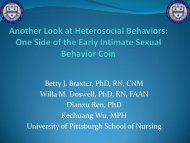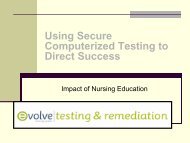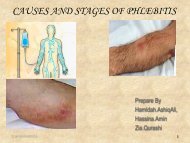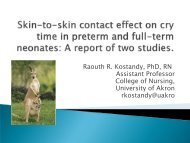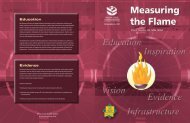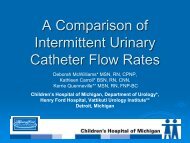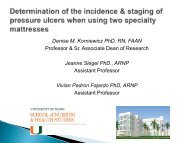Evaluating a Community Based Family Caregiver Training ... - IUPUI
Evaluating a Community Based Family Caregiver Training ... - IUPUI
Evaluating a Community Based Family Caregiver Training ... - IUPUI
You also want an ePaper? Increase the reach of your titles
YUMPU automatically turns print PDFs into web optimized ePapers that Google loves.
Developing and<br />
<strong>Evaluating</strong> a <strong>Training</strong><br />
Program Responsive to<br />
<strong>Family</strong> <strong>Caregiver</strong> Needs<br />
Janet Witucki Brown, PhD, RN, CNE;<br />
Shu-li Chen, PhD, RN; Pratsani<br />
Srikan, MSN;<br />
The University of Tennessee,<br />
Knoxville, College of Nursing
Funding<br />
• Funding for this study provided by the<br />
University of Tennessee Health Science<br />
Center
Background<br />
• Care of a family member with multiple<br />
needs at home can be very challenging.<br />
Multiple skills are needed. Many family<br />
caregivers provide some type of<br />
"nursing care" for their loved ones<br />
often with no training
Purpose<br />
• The purpose of this mixed methods<br />
study with data triangulation was to<br />
evaluate a <strong>Family</strong> <strong>Caregiver</strong> <strong>Training</strong><br />
Program: Helping Others Provide<br />
Exceptional Care (HOPE ).<br />
• Both the actual training program itself<br />
and the impact of the training program<br />
on family caregivers were evaluated.
Theoretical Framework<br />
• The goal of this outcomes research is<br />
the evaluation of outcomes as defined<br />
by Donabedian (1987).
Study Design<br />
• This pilot study used a mixed methods<br />
timed series outcomes study with data<br />
triangulation of both quantitative and<br />
qualitative data.<br />
• Data was collected prior to beginning<br />
the classes (Time 1), immediately after<br />
(Time 2) and one month after (Time 3).
Instruments<br />
• Time 1- Prior to beginning the FCTP class:<br />
<strong>Caregiver</strong> demographic questionnaire, Care<br />
recipient demographic questionnaire, & Adapted<br />
Revised Caregiving Appraisal Scale<br />
• Time 2- Immediately following the completion<br />
of the FCTP: Post Program Evaluation Survey<br />
& Adapted Revised Caregiving Appraisal Scale<br />
• Time 3- Approximately one month after<br />
completion of the FCTP: Adapted Revised<br />
Caregiving Appraisal Scale, Follow-up Post<br />
Program Survey
Data Analysis<br />
• Descriptive statistics for demographic<br />
data<br />
• Friedman’s Two-way analysis of<br />
variance for quantitative data<br />
• Krippendorff’s (2004)content analysis<br />
for qualitative data.
HOPE <strong>Training</strong> Program<br />
• <strong>Based</strong> upon the Minnesota <strong>Family</strong> Workshop<br />
(Ostwald, Hepburn & Burns, 2003)<br />
• Main aims:<br />
– increase caregivers’ knowledge<br />
– Increase family’s insight<br />
– Help caregivers develop new skills<br />
– Increase sense of self-efficacy<br />
– Help with understanding of caregiving situation<br />
– Increase awareness of community resources
Findings: Demographics<br />
• The majority of caregivers (n=58) were:<br />
– female (81%)<br />
– married (76%)<br />
– Caucasian (91%)<br />
– Ages ranged from 42-90 years old.<br />
• Thirteen caregivers were caring for<br />
more than one care recipient and one<br />
caregiver provided care for three family<br />
members.
• Care recipients (n=70) were:<br />
– mostly female (63%)<br />
– 50% married<br />
– 96% Caucasian<br />
– Ages ranged from 46 to 105 years of<br />
age<br />
– 51.7% had a diagnosis of dementia<br />
– 49.1% had moderate to severe<br />
impairment
Quantitative Survey Findings<br />
• Time 1, n=58; Time 2, n=30; Time 3, n=<br />
19.<br />
• Adapted Revised Caregving Appraisal<br />
Scale (entire scale)<br />
– No difference between Times 1 and 2<br />
– No difference between Times 2 and 3<br />
– No difference between Times 1 and 3<br />
– Significant difference among the three<br />
survey points (x 2 = 10.21; p< 0.01)
• Revised Caregving Appraisal Scale<br />
(subscales)<br />
– Statistically significant differences at all<br />
three points on subscale of caregiving<br />
satisfaction (x 2 = 8.05; p< 0.05)<br />
– Significant increase in caregiving<br />
satisfaction between Time 1 and Time 3<br />
and Time 2 and Time 3<br />
– No significant differences on subscales of<br />
burden, mastery, demand, or impact
Post Program Evaluation Survey<br />
Quantitative Results<br />
• Over 96% of caregivers reported<br />
– positive increases in knowledge,<br />
confidence, and skills acquisition<br />
– Clarity and importance and time<br />
presentation of materials<br />
– Timing of program, valuing of questions<br />
and opinions, usefulness of information<br />
*100% would recommend the program to<br />
others
Post Program Evaluation Survey<br />
Qualitative Results<br />
• Participants made suggestions regarding:<br />
– Timing of classes<br />
“The lawyer needed more time”<br />
– Content of classes<br />
• “Council on Aging representative gave<br />
too much information for me to absorb it<br />
all”<br />
• “When should they be put in the nursing<br />
home-more about cost and nursing<br />
home in our area”
– Presentation of content<br />
• “Could all speakers have an outline<br />
to give us so we could write on<br />
them, and they could stop on topic<br />
and on time”
• This feedback was used to modify<br />
subsequent classes to make them more<br />
responsive to caregivers’ needs<br />
– The program was reduced to four weeks<br />
from six weeks after first two classes<br />
– Content was modified or added ( more<br />
handouts used, timing of material)
Qualitative Findings: Themes<br />
• Applicability/Usefulness<br />
– Information<br />
• “Finding out about services available at county<br />
and state levels that I was unaware of”<br />
• “Information presented by the nurse regarding<br />
nutrition, recovery from broken hip and drug<br />
interactions”<br />
– Skills<br />
• “I am more cognizant in the importance of<br />
keeping mom stretched, flexed & exercised”<br />
• “Have used some of the techniques to divert<br />
conversations or responding to the emotion”
• Socialization<br />
– “Makes one feel they are not alone as well<br />
as making one feel that where a problem<br />
might be difficult it can be taken care of”<br />
– “Also seeing other folks and realizing my<br />
problems are universal and there is help<br />
there”
• Satisfaction<br />
– I think this training is invaluable for<br />
everyone caring for ailing loved ones”<br />
– “You gave me a boost to keep going”<br />
– “I felt that the program was a very much<br />
needed program- that so many people are<br />
in my shoes and these shoes are very<br />
uncomfortable”
• Barriers/Facilitators<br />
– Barriers<br />
• “Most people are not aware of this program. I<br />
saw the article in the newspaper or I might<br />
never know”<br />
• “Timing….If I were working, I would not have<br />
been able to attend”<br />
– Facilitators<br />
• “Our evenings are mostly free which made our<br />
evening class perfect.”<br />
• “The location was close to my home. The time<br />
during the day was convenient.”
• Confidence<br />
– “I have a little more confidence in certain areas<br />
after talking the training in regards to caring for<br />
mom.”<br />
– “We have so much more confidence in our ability<br />
to find the help we need”<br />
• Planning Ahead<br />
– “We are changing and updating wills, living wills,<br />
and POAs to meet Tennessee requirements”<br />
– “I found the information very helpful in case I find<br />
myself caring for a relative and have saved the<br />
information for my sons if they have to care for<br />
me”
Limitations<br />
• Majority of sample was Caucasian-<br />
There may be differences in content<br />
needed by other ethnic groups<br />
• Loss of participants from Time 1 to<br />
Time 2<br />
• Small sample size at Time 2 and 3 did<br />
not meet power analysis requirements
Discussion<br />
• <strong>Caregiver</strong>s were satisfied with the<br />
HOPE training and were using what<br />
they learned.<br />
• <strong>Caregiver</strong>s may be caring for more than<br />
one care recipient- unexplored area for<br />
research<br />
• Adaptation of the Revised Caregiving<br />
Appraisal Scale from a verbal to paper<br />
& pencil instrument showed good<br />
psychometric properties



